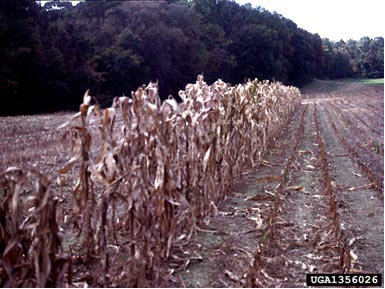Nematodes - maize
Contributors to this section: CIMMYT, Mexico (Etienne Duveiller, Monica Mezzalama, Eloise Phipps, Thomas Payne, Jesper Norgaard), Independent consultant (Jesse Dubin).
Maize cyst nematode, corn cyst nematode
Scientific Name
Heterodera zeae
Importance
High economic importance, moderate phytosanitary importance.
Significance
H. zeae is widely distributed in India, Pakistan and Egypt and is presently growing in importance since its detection in the USA, where maize is cultivated over large areas. In India it is considered to be one of the four most important cyst nematodes in that country and is an economic pest of maize. Although accurate estimates of economic crop loss are not available, maize yield has been reported to decline with infestation even when the plants have been exposed to good cultural and fertilization practices, indicating that the decline in yield is due mainly to infestation by H. zeae. Losses appear to be greater in coarse-textured than in fine-textured soil, and greater during hot, dry seasons than in cool, wet seasons.
Symptoms
As with other cyst nematodes, the presence of cysts on the root surface is the most important characteristic used in the identification of H. zeae. Therefore, the most important stage for identification is after the formation of cysts. Above-ground symptoms are very similar to those brought about by other plant parasitic nematodes and include patchy areas with unthrifty, stunted plants having chlorotic and narrowed leaves.
 Corn cyst nematode damages (Jonathan D. Eisenback, Virginia |
Hosts
Major hosts: maize.
Minor hosts: oats (Avena sativa), barley (Hordeum vulgare), rice (Oryza sativa), foxtail millet (Setaria italica), sorghum (Sorghum bicolor), Sudan grass (Sorghum sudanense), wheat, teosinte.
Wild hosts: grasses (Poaceae).
Geographic distribution
India, Pakistan, Egypt, and the USA.
Biology and transmission
H. zeae is reported to have both endoparasitic and semi-endoparasitic habits. The adult females are sedentary and remain within or attached semi-endoparasitically to the roots.
Temperature and soil type play important roles in the biology of H. zeae. As is the case with other Heterodera species, the root diffusate leaching out from the growing roots of host plants also significantly influences the hatching of the eggs. The optimal temperature for the emergence of juveniles from cysts is thought to be between 25 and 33°C. The life cycle is very short and H. zeae is able to complete about 6-7 generations during one cropping season.
Spread of H. zeae by itself is limited. Movement results mainly from flooding, drainage or other forms of transport, soil washings, farm machinery, livestock, seed, grain, tools or people. Every effort should therefore be taken to ensure the prevention of transport of infested material to hitherto uninfested areas and to maintain high standards of sanitation.
Detection/indexing methods used at CIMMYT
- Physical inspection of seed.
Treatment/control
- No seed treatment
Procedures followed in case of positive test used at CIMMYT
- The seed lot is destroyed (the pathogen is quarantined in Mexico).
References and further reading
CAB International. 2007. Datasheet: Heterodera zeae. In Crop Protection Compendium, 2007 Edition. Published as CD-ROM and website. Wallingford, UK: CAB International.
Comments
- No comments found

Leave your comments
Post comment as a guest